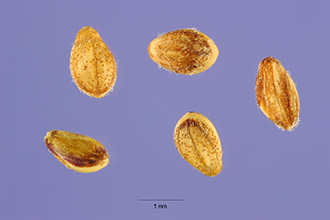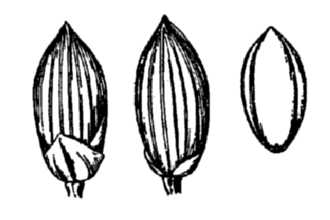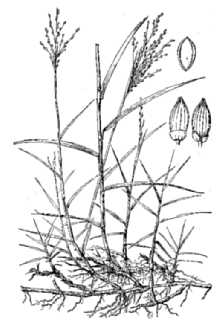Panicum gouinii Fourn.
Scientific Name: Panicum gouinii Fourn.

| General Information | |
|---|---|
| Usda Symbol | PAGO |
| Group | Monocot |
| Life Cycle | Perennial |
| Growth Habits | Graminoid |
| Native Locations | PAGO |
Plant Guide
Alternative Names
Bullet grass, bullet grass, coastal bermuda grass, couch panicum, creeping panic, dogtooth grass, panic rampant, quack grass, torpedo grass, wainaku grass. A synonym of torpedo grass is Panicum gouinii.
Uses
Livestock: It was once used for cattle in the 1920s and is resistant to grazing and trampling; however, better forages are now available that has higher quality and does not create the potential weed problems that torpedo grass did. Wildlife: Waterfowl and songbirds regularly use torpedo grass. It is an excellent forage plant for several mammals. Erosion Control: Torpedo grass is recommended for the use of shoreline stabilization. It may be used in areas that have periods of both inundation as well as drought. Conservation Practices: Torpedo grass, because of its growth habit, potentially has application when established with certain conservation practices; however, conservation practice standards vary by state. For localized information, consult your local NRCS Field Office. Grass Images @ Texas A&M University
Status
Consult the PLANTS Web site and your State Department of Natural Resources for this plant’s current status, such as, state noxious status and wetland indicator values.
Description
General: Grass Family (Poaceae), It is a warm season, rhizomatous perennial, which may form extensive colonies, The rhizomes have characteristic torpedo-like apexes, hence the common name torpedo grass, The culms are erect, glabrous, and rigid and range in height from 12 to 31 inches, The sheaths are glabrous or pubescent with thin and dry margins, The leaf blades are mostly short, flat, or rolled in tightly, If flat, the blades are approximately ¹⁄8 inch wide and if folded, the blades are approximately ¼ inch wide, The ligules are membranous with fringed hair surrounding them, The panicles are open, loose, 4 to 7 inches long, and with strongly ascending branches, The spikelets are straw colored and ¹⁄16 inch long, The first glume is short and truncate, The second glume and sterile lemma are about equal in size and apically acute to acuminate with 7 to 9 weak nerves, The sterile pale is thin and dry, The fertile lemma and palea are straw colored and sharply angled, The caryopsis is pale yellow and oval in shape, Use soil moisture sensors to measure the soil moisture of Panicum gouinii Fourn..,
Distribution
Torpedo grass is found in marshy shores along the Gulf Coast from Florida to Texas and along tropical and subtropical coasts around the world. It is also found in disturbed sites, canals, and in poorly drained soil. It is possibly introduced to Louisiana and the United States. Linneaus in Europe first described torpedo grass in 1762. It was first collected in North America near Mobile, Alabama in 1876. For current distribution, consult the Plant Profile page for this species on the PLANTS Web site.
Establishment
Adaptation: It may grow off shores and into water up to 6 feet deep forming a thick dense floating mat. Torpedo grass begins to grow in February and the seeds are formed in July. They cannot tolerate cold weather and will die after the first frost. The dry grass in winter retains a relatively high nutrient content. Once established, torpedo grass is difficult to eradicate. It can be distributed by using improper soil sanitation and by tilling and fertilizing. Torpedo grass is tolerant of drought and partial shade, and can grow on heavy upland soils. It thrives best on moist to wet sandy or organic soil. Torpedo grass is propagated by seed or by plant division; however the best propagation method is through plant division. The seeds are variable in abundance and viability. The rhizomes can be dug and cut into segments, which will then sprout new shoots. The stems may also be cut and propagated. It is not recommended to mix torpedo grass seeds with cool season grass seeds. In parts of the United States where cool season grasses dominate, the warm season grasses can be taken over because they develop slower than the cool season grasses. It is also recommended that seed not be moved more than 300 miles north, 100 miles east or west, or 200 miles south of its point of origin.
Management
To maintain existing torpedo grass colonies, avoid long term deep flooding and abusive livestock grazing. The plant prospers with periodic fire provided sufficient soil moisture is present to avoid scorching root systems. Once established, it is difficult to kill. Check with the local extension service for recommended herbicides. Torpedo grass has no known pests or problems. Cultivars, Improved and Selected Materials (and area of origin) Contact your local NRCS Field Office. Common seed and container plants are readily available from a number of growers, wholesalers, and retailers of native seed.
References
Hitchcock, A.S. 1950. Manual of the grasses of the United States. USDA Miscellaneous Publication No 200. Agricultural Research Administration, Washington, D.C. Pp. 697. Texas A&M University 1997. Grass images: Panicum repens. <http://www.csdl.tamu.edu/FLORA/taesgrass/4644100e.jpg>. Bioinformatics Working Group, College Station, Texas. USDA NRCS 2003. The PLANTS database. Version: 10aug03. National Plant Data Center, Baton Rouge, LA. <http://plants.usda.gov>


